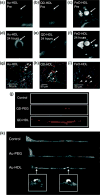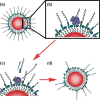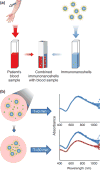Emerging applications of nanotechnology for the diagnosis and management of vulnerable atherosclerotic plaques
- PMID: 21834059
- PMCID: PMC5486233
- DOI: 10.1002/wnan.158
Emerging applications of nanotechnology for the diagnosis and management of vulnerable atherosclerotic plaques
Abstract
An estimated 16 million people in the United States have coronary artery disease (CAD), and approximately 325,000 people die annually from cardiac arrest. About two-thirds of unexpected cardiac deaths occur without prior recognition of cardiac disease. A vast majority of these deaths are attributable to the rupture of 'vulnerable atherosclerotic plaques'. Clinically, plaque vulnerability is typically assessed through imaging techniques, and ruptured plaques leading to acute myocardial infarction are treated through angioplasty or stenting. Despite significant advances, it is clear that current imaging methods are insufficiently capable for elucidating plaque composition--which is a key determinant of vulnerability. Further, the exciting improvement in the treatment of CAD afforded by stenting procedures has been buffered by significant undesirable host-implant effects, including restenosis and late thrombosis. Nanotechnology has led to some potential solutions to these problems by yielding constructs that interface with plaque cellular components at an unprecedented size scale. By leveraging the innate ability of macrophages to phagocytose nanoparticles, contrast agents can now be targeted to plaque inflammatory activity. Improvements in nano-patterning procedures have now led to increased ability to regenerate tissue isotropy directly on stents, enabling gradual regeneration of normal, physiologic vascular structures. Advancements in immunoassay technologies promise lower costs for biomarker measurements, and in the near future, may enable the addition of routine blood testing to the clinician's toolbox--decreasing the costs of atherosclerosis-related medical care. These are merely three examples among many stories of how nanotechnology continues to promise advances in the diagnosis and treatment of vulnerable atherosclerotic plaques.
Copyright © 2011 John Wiley & Sons, Inc.
Figures





References
-
- Lloyd-Jones D, Adams RJ, Brown TM, Carnethon M, Dai S, De Simone G, Ferguson TB, Ford E, Furie K, Gillespie C, et al. Heart disease and stroke statistics—2010 update: a report from the American Heart Association. Circulation. 2010;121:e46–e215. - PubMed
-
- Insull W., Jr The pathology of atherosclerosis: plaque development and plaque responses to medical treatment. Am J Med. 2009;122:S3–S14. - PubMed
-
- Naghavi M, Falk E. Asymptomatic Atherosclerosis. New York, NY: Humana Press; 2010. From vulnerable plaque to vulnerable patient; pp. 13–38.
-
- Sousa JE, Serruys PW, Costa MA. New frontiers in cardiology: drug-eluting stents: part I. Circulation. 2003;107:2274–2279. - PubMed
-
- Finn AV, Nakazawa G, Joner M, Kolodgie FD, Mont EK, Gold HK, Virmani R. Vascular responses to drug eluting stents: importance of delayed healing. Arterioscler Thromb Vasc Biol. 2007;27:1500–1510. - PubMed
FURTHER READING
-
- Buxton DB. Current status of nanotechnology approaches for cardiovascular disease: a personal perspective. WIREs Nanomed Nanobiotechnol. 2009;1:149–155. - PubMed
-
- Puskas JE, Muñoz-Robledo LG, Hoerr RA, Foley J, Schmidt SP, Evancho-Chapman M, Dong J, Frethem C, Haugstad G. Drug eluting stent coatings. WIREs Nanomed Nanobiotechnol. 2009;1:451–462. - PubMed
Publication types
MeSH terms
Grants and funding
LinkOut - more resources
Full Text Sources
Other Literature Sources
Miscellaneous

